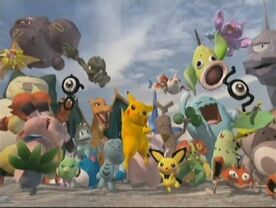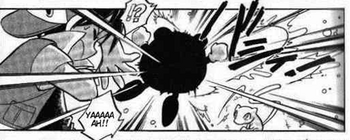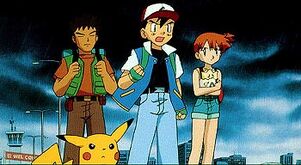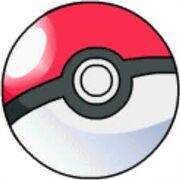
Originally released in 1996 in the form of two video games, Pokémon Red and Pokémon Green, Pokémon has since gained worldwide media and attention, and become one of the leading trademarks of the Nintendo company in the form of the Electric Mouse Pokémon, Pikachu.
In the world of fanfiction, however, Pokémon tend to serve a more notorious purpose. Due to the sheer cuteness of some Pokémon, and the variety, many Suethors take it upon themselves to fulfill the Pokémon catchphrase "Gotta Catch 'Em All" with their own characters, resulting in a Trainer!Sue. The Pokémon fandom can be considered the video game equivalent of the Tolkien fandom in terms of sheer number of Sues: as of this writing, there are more Pokémon fics on the Pit (78.3 thousand) than there are for The Lord of the Rings, The Hobbit, and The Silmarillion combined (66.8 thousand).
Sub-Continua[]
The Pokéverse can generally be divided into four realms: the 2D games (Gens I-V), the 3D games (Gen VI on), the manga (while there are several, the one most commonly known is Pokémon Adventures, also known as Pokémon Special, which is the most popular), and the anime. The majority of Sues by far focus on the anime, since it has had the widest exposure; game-verse Sues come in second, and manga-verse Sues are rare but not unheard of.
Pokémon Special Manga[]

Red battles Mew in the manga.
- "This is the comic that most resembles the world I was trying to convey."
- —Satoshi Tajiri
Pokémon Special's world is that of the games, but considerably darker and more dramatic. It is divided into multiple arcs based off of the games: the Red/Blue/Green arc and connected Yellow arc, the Gold/Silver/Crystal arc, the Ruby/Sapphire arc, the FireRed/LeafGreen arc, the Emerald arc, the Diamond/Pearl/Platinum arc, and most recently the Black/White arc. (There's probably an XY and Sun and Moon arc too, we just don't know about it yet.) The manga is being translated into English by a publishing company in Singapore, Chuang Yi, and these translations are currently up to Volume 28, in the Emerald arc.
In Pokémon Special, Team Rocket is much more powerful and prominent than in the games or anime, and the struggles between the heroes and villains wind up causing considerably more property damage than in other adaptions (the Hoenn conflict practically annihilates the region, for example). The protagonists are versions of the player character and rival from each associated generation of the game.
The Anime[]
Probably the first thing people think of when they think of Pokémon, or anime in general. This is not a bad thing, as the anime can be quite enjoyable. (Note: There are a lot of characters, so the following "Main characters" list applies to the Kanto, Orange Islands, and Johto arcs only. Click here for more information.)
Main characters[]

Brock, Ash and Misty, as well as their Pokémon, Pikachu and Togepi.
- Ash Ketchum is a perpetually ten-year-old boy who dreams of being the Greatest Pokémon Master in the world. Ash's specialty is winning using unique strategies, often winning battles where he is at a distinct disadvantage.
- Misty is a Gym Leader of Cerulean City (one of four sisters in the anime in charge of that Gym), who is frequently paired with Ash in fanfiction (PokéShipping). Misty's specialty is Water-type Pokémon, but has shown skill in using a variety of other Pokémon.
- Brock is the ex-Gym Leader of Pewter City. Brock aims to become a Pokémon Breeder, and is known for lusting after (among other side characters) the many Nurse Joys and Officer Jennies (apparently he can tell them all apart). Brock's specialty is using Rock and/or Ground-type Pokémon.
- Professor Samuel Oak is a leading world authority on Pokémon. Professor Oak was the one who gave Ash his Pikachu, and maintains a lab on the outskirts of Pallet Town.The movie Pokémon 4ever implies that a young Samuel Oak ("Sammy") befriended the legendary Pokémon Celebi.
- Tracy Sketchit is a young Pokémon Watcher who idolizes Professor Oak. He briefly journeyed with Ash and Misty in the Orange Islands arc, but left to become Professor Oak's helper.
- Team Rocket is an expansive criminal organization led by the mysterious Giovanni. In the show, "Team Rocket" most often refers to the three characters of Jessie, James, and Meowth, all members of the organization, who serve as Ash's most persistent and constant nemeses. Though originally serious opponents to Ash, overuse and continual reuse as the series progressed has turned Team Rocket into the series' longest-running joke in the eyes of most of the viewing audience, and their incompetence is a practical legend. However, in the Best Wishes season, their competence seems to have taken a boost.
- Jessie is the de facto leader of the trio. Originally from a poor family, she joined the Rockets in search of something better and quickly rose through the ranks (though after running into Ash for the first time, she appears to have hit a wall in that respect). Her personality is aggressive and prone to angering easily. (It's also strongly hinted that she makes all of the trio's disguises.)
- James is the group's other human member. While originally from a rich family, he ran away long ago to avoid being forced into marriage with a woman he despised (by an odd coincidence, she looks almost exactly the same as Jessie), and eventually wound up with Team Rocket. James is usually responsible for the team's planning and machinery. He is also flamboyant to the point where a large portion of the fanbase believes him to be queer as a three dollar bill.
- Meowth is the team's third member, and is notable as the only (non-telepathic) Pokémon in the series that speaks English. He learned this talent in an attempt to impress a female Meowth he loved, but she viewed him as a freak. This rejection eventually drove him into Team Rocket, though exactly how he fell in with Jessie and James is unclear.
Pokémon[]
Pokémon are a collection of creatures who have the power to influence and control the various elements in nature. As of the eighth generation of Pokémon games, Sword and Shield, the total amount of different Pokémon species (including the two expansion packs) rests at 898.
The games have a simple plot: You, a child in whatever small town, get your starter Pokémon and set off to catch other Pokémon who will help you defeat everyone in your path, including your rival, countless other NPCs, eight Gym Leaders, an evil organization trying to take over/destroy your region, and ultimately the Pokémon League's Elite Four and Champion. Have fun!
Note: The following list covers the main series games only. The Pokémon games have multiple spinoff series, each of which takes place in its own universe.
- Generation I - The oldest and best-known (among non-fans) generation of Pokémon, this generation covers Pokémon Red, Green (Japan-only), Blue, and Yellow versions. This introduced all the basic elements of the game franchise that haven't changed (much) in 20 years. There are 151 different species of Pokémon in the first generation, five of which are Legendary Pokémon (very rare and powerful Pokémon equivalent to deities). It's occasionally known as the "Color (or Colour) Generation", and contains a notorious amount of glitches. The games are very fondly remembered by those who played them, to the point of the later generations being actively disparaged by some people ("Genwunners"). Iconic Pokémon include Bulbasaur, Charmander, Charizard, Squirtle, Pikachu, Jigglypuff, Eevee, Mewtwo, and Mew.
- Generation II - Possibly the most highly regarded generation, the second generation brought the total number of Pokémon species up to 251, with an additional six Legendary Pokémon and two new types, Steel and Dark. (The elemental typing system was...poorly balanced in Gen I; the Steel-type and Dark-type were created to nerf Psychic-types.) This generation was added in the games of Pokémon Gold, Silver, and Crystal. This is occasionally called the "Metal (or Metallic) Generation" despite Crystal's presence. Crystal is noteworthy for including the first female player character and, in the Japanese version, online play via mobile phones. Iconic Pokémon include Chikorita, Cyndaquil, Totodile, Togepi, Marill, Lugia, Ho-oh, and Celebi.
- This is the first generation in which Legendary Pokémon were part of the main story. Ho-Oh, Lugia, and Suicune challenge the player after he/she earns the seventh Gym Badge and clears the Goldenrod Radio Tower.
- Generation III - Often called the "Advanced Generation" due to the games releasing on the Game Boy Advance and also being released as a rebirth to the series, this generation introduced 135 new Pokémon in Pokémon Ruby, Sapphire, and Emerald versions. Pokémon Red and Green were also remade into Pokémon FireRed and LeafGreen during this generation. Although Ruby and Sapphire were the best-selling games on the Game Boy Advance, Gen III is often the most disliked generation due to the fact that it changed a lot of aspects within Pokémon (including species design; Ken Sugimori did not create almost all the art as he had earlier), as well as being released during a low point of popularity for the series. (Apparently Yu-Gi-Oh! was cool in 2003.) Iconic Pokémon include Treecko, Torchic, Mudkip, Plusle, Minun, Kecleon, Groudon, Kyogre, Rayquaza, Deoxys, and Jirachi.
- Ruby and Sapphire are noteworthy for having a different story depending on which version you play. In Ruby, you stop Team Magma from awakening Groudon to create more land; in Sapphire, you stop Team Aqua from awakening Kyogre to create more water. Emerald players get to stop both of these evil plans.
- Generation IV - Pokémon Diamond, Pearl, and Platinum introduced 107 new Pokémon, with an incredible 14 of these being Legendary Pokémon. Gold and Silver were also remade into Pokémon HeartGold and SoulSilver during this generation. Pokémon Diamond and Pearl were also notable for being some of the first hand-held games to introduce internet capabilities, thanks to the Wi-Fi-enabled Nintendo DS. It is called the "3D Generation" on Bulbapedia, due to Diamond and Pearl being the first main series games that use 3D graphics. Because of the aforementioned online capabilities, various improvements to gameplay, the later released Generation II remakes, and the DS's outstanding popularity, it is regarded as a true revival to the series (Diamond and Pearl outsold the previous two iterations). Iconic Pokémon include Turtwig, Chimchar, Piplup, Lucario, Dialga, Palkia, Giratina, Manaphy, Darkrai, Shaymin, and Arceus.
- Diamond and Pearl continue the trend of the story differing between games, but Team Galactic's ultimate goal is the same. The difference is which ancient dimensional dragon-god Cyrus wants to help him create a new universe.
- Generation V - Black and White introduced 156 new Pokémon, the most of any single generation, including the version-exclusive Legendary Pokémon, Reshiram and Zekrom. It was released for the Nintendo DS like Generation IV, despite the release of the Nintendo DSi in 2008 (Japan) and 2009 (internationally) and the introduction of the Nintendo 3DS in 2010. It is also called the "Monochrome Generation" on Bulbapedia. Along with said Legendaries, iconic Pokémon include Snivy, Tepig, Oshawott, Zorua, Zoroark, Minccino, Klink, Darmanitan, Pidove, Sandile, Munna, and Blitzle. This is the only generation with sequels—Black 2 and White 2—that use the same engine as their predecessor.
- This generation's Team Plasma is notable because, at least initially, they challenge the whole concept of Pokémon and humans working together. They (and N Harmonia in particular) believe the partnership is inherently abusive and Pokémon don't need humans to fight and grow stronger.
- Generation VI - The most recent Generation introduced the least new Pokémon thus far, with a mere 70 making their debuts in X and Y, including version-exclusive Legendaries Xerneas and Yveltal. However, the sixth generation differs in a lot of other ways, with the first new type—Fairy—added to the games since Generation II, a whole new method of evolution, and a radically different graphical style; rather than sprites, X and Y use fully-3D models. You can also run diagonally, which is just madness. Iconic Pokémon (aside from the Legendaries) include Fennekin, Chespin, Froakie, Goodra, Zygarde, Floette, Gogoat, Vivillon, Pangoro, Aegislash, and Helioptile. Also, over the course of 2014, Ruby and Sapphire were remade and re-released as Omega Ruby and Alpha Sapphire. Fans across the Internet rejoiced. These remakes confirm that the 2D games are a separate continua from the 3D games.
Types of Pokémon[]
- Bug
- Dark
- Dragon
- Electric
- Fairy
- Fighting
- Fire
- Flying
- Ghost
- Grass
- Ground
- Ice
- Normal
- Poison
- Psychic
- Rock
- Steel
- Water
Pokémon can have one type (Squirtle, a Water-type) or two (Lugia, a Psychic/Flying type). In addition, some "glitch Pokémon" (Pokémon only able to be caught via exploiting bugs in the code) have the Bird type.
Poké Balls[]
Along with Pikachu, the Poké Ball remains one of the franchise's most defining trademarks. Essentially a baseball-sized red and white sphere, it transforms a Pokémon into energy when it is thrown, and successfully hits, a Pokémon. If a Pokémon is strong enough, it will break out of the ball. There are several types of Poké Ball, some of which are designed to work best at capturing Pokémon in specific circumstances; at night, for example, or if the player is fishing.

The standard Poké Ball.
The four basic types of Poké Ball are:
- Poké Ball - The most common type, and the easiest for Pokémon to escape from. Has a red-and-white motif.
- Great Ball - Has a greater chance of capturing than a Poké Ball. Has a blue-and-white motif with a "G" above the button.
- Ultra Ball - Has a higher capture rate than a Great Ball. Is colored yellow, black and white, with a "U" above the button.
- Master Ball - The best kind of Poké Ball (100% capture rate) and therefore the rarest. Has a purple-and-white motif, with circles of lighter purple on the upper side and an "M" above the button.
In Badfic[]
Pokémon is particularly susceptible to mini creation, due to that "é" in the title and the many, many official terms with the prefix "Poké-" attached. "Poké Ball" is also frequently misspelled (as "Pokéball") due to being a two-word phrase, bucking the trend of having "Poké-" and the noun it modifies be attached. In general, Pokémon names are a bit hard to grasp as well, leading to more potential for misspellings.
Shipping[]
Shipping is very common in the Pokémon fandom, especially where the anime is concerned. Ash Ketchum alone has twenty-seven pairings with various people and Pokémon (yes, really). These ships are frequently in a state of conflict with each other, with savage flamewars being frequent. Not only that, but the usual OOCness that is associated with shipfics rivals Harry Potter in its intensity, with character bashing being common.
In the fandom's defense, some of the best Pokémon fanfics were written with the intention of pairing two characters together.
Sue Types[]
Pokémorphs[]
Part-Pokémon Sues.
Despite what the name implies—a Pokémon equivalent to Animorphs—most Pokémorphs are handled entirely differently, either becoming an anthropomorphic Pokémon or (the vastly more popular alternative) regular people with Pokémon ears and a tail, or other unproblematic and unnoticeable Pokémon parts. The number of these Sues seem to have diminished in recent years.
New Trainers[]
Sues that have SPECIAL Pokémon and impress everyone with their skills, beat all opposing Trainers quickly and easily, make one-in-eight-thousand(-one-hundred-ninety-two) chance Shiny Pokémon flock to them, etc.
- Note: It is possible for a person to plow through all of the gyms in their chosen region in two-three days as far as the games are concerned. However, it takes far longer on the television series, and don't even get started on the Elite Four.
Some other common Sue traits are:
- The ability to talk to Pokémon, either naturally (displayed in canon by N Harmonia, maybe) or through a machine;
- The lack of a biological father—a leaf taken from Ash Ketchum's book—typically played for wangst;
- Being some sort of Chosen One, selected by the Legendaries (equivalent of deities, remember) to save the world from some horrific evil;
- Capturing a Legendary (usually);
- The ability to make all Pokémon love and follow them without question before earning any Gym Badges (this distinction is important);
- Having one person either hate them for no apparent reason or wish to make them better as a Trainer, turning them into a "Rival" whom they will almost always defeat;
- Having something rare like an Riolu or a Dratini as a starter;
And other such wonders. They are, of course, susceptible to the universal Sue difficulties.
In the PPC[]
While agents are permitted to own Pokémon, the care and possession of such are considered entirely the agent's responsibility, to be paid for out of their own pocket (similar to the rules regarding minis). HQ rules strictly forbid Pokémon battles in the hallways, though some of the more obsessed Trainers have given thought to setting up an arena for Pokémon battles somewhere (this has not gone anywhere yet).[source, please!] Agents working in the Pokémon world are not to engage in Pokémon battles with canons except for the purpose of distracting them from the Mary Sue; similarly, they are not to engage Pokémon Trainer Sues in battle except for the purpose of distracting them from their partner. There are agents that hail from the Pokémon continuum, and the Black Cats' Mike Jarvis may or may not have been part of the DIS.
Agents from this Continuum[]
- Alexis Green
- Chris
- Doktor Trollenfisch
- Falchion
- Gabrielle
- Kippers Axolotl
- Lapis Lazuli
- Lunac
- Samuel
- Sasha Lipsen
- Shay Williams
- Zeb
OFU and Minis[]
Throughout the years, Pokémon has been served by two separate OFUs. The more current one is the Official Pokémon Fanfiction University, written by The Warrior of Many Faces. It can be read here and is the source of the official Pokémini, the mini-Missingno. The original was the Official Fanfiction University of Kanto, written by Saiyan Princess TRF. This one actually used the now-defunct mini-Deoxys (explained as Arceus changing the minis' nature at that campus).
Missions in this Continuum[]
- "An Act of Sheer Will", Agents Falchion and Velociripper (DF) with Agents Rina Dives and Randa Roan (DMS)
- "Banned From Johto", Agents Chris and Ami Seeker (DF), with Trainees Miguel and Violet
- "It's Elf's World!" (crossover with The Zombie Survival Guide), Agent Lucius (DF) with Agents Thomas and Orken (DMS - Sci-Fi/Steampunk)
- "Luke," Agents Soledad and Claire (DMS)
- "Mewtwo's Anger, Amon's Passion," Agents Karma and Nemia (DMS - Doctor Who/Torchwood)
- "Pilot" (crossover with World One), Agents Chris and Ami Seeker (DF) with Agent Falchion (DF)
- "Secrets," Agents July and Library (DF) with Agents Samuel and Katrina (DMS) (alternative links)
